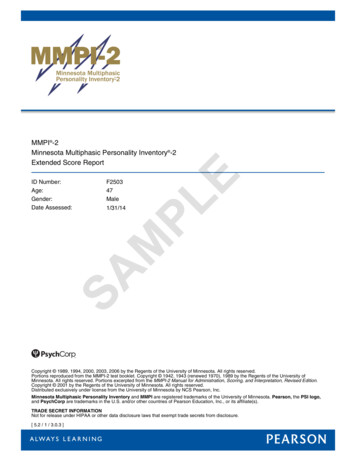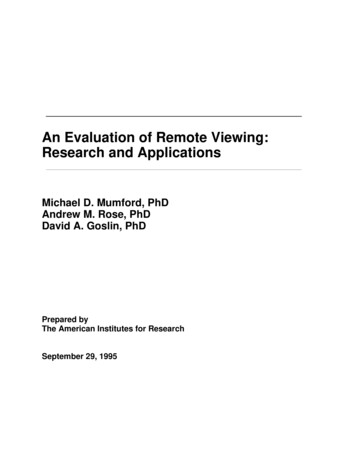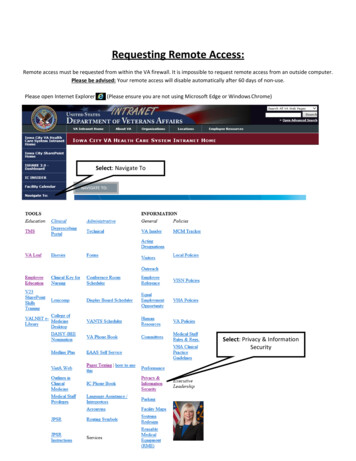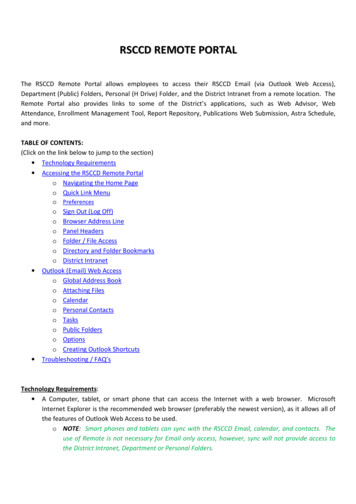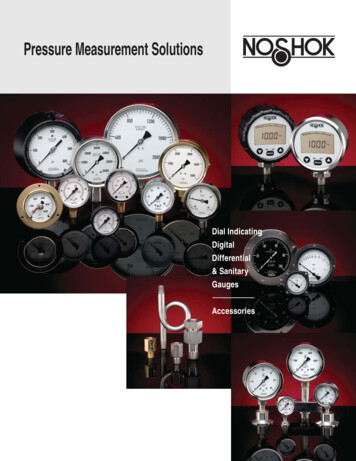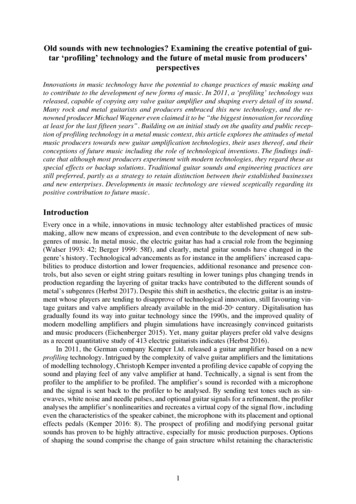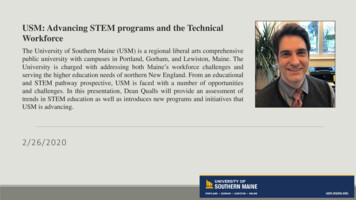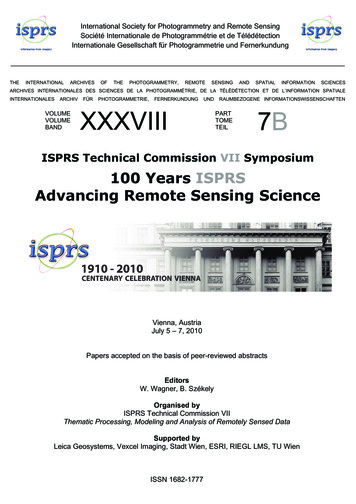
Transcription
International Society for Photogrammetry and Remote SensingSociété Internationale de Photogrammétrie et de TélédétectionInternationale Gesellschaft für Photogrammetrie und RCHIVES INTERNATIONALES DES SCIENCES DE LA PHOTOGRAMMÉTRIE, DE LA TÉLÉDÉTECTION ET DE L’INFORMATION HOTOGRAMMETRIE,FERNERKUNDUNGUNDXXXVIIIRAUMBEZOGENE INFORMATIONSWISSENSCHAFTENPARTTOMETEIL7BISPRS Technical Commission VII Symposium100 Years ISPRSAdvancing Remote Sensing ScienceVienna, AustriaJuly 5 – 7, 2010Papers accepted on the basis of peer-reviewed abstractsEditorsW. Wagner, B. SzékelyOrganised byISPRS Technical Commission VIIThematic Processing, Modeling and Analysis of Remotely Sensed DataSupported byLeica Geosystems, Vexcel Imaging, Stadt Wien, ESRI, RIEGL LMS, TU WienISSN 1682-1777
This compilation 2010 by the International Society for Photogrammetry and Remote Sensing.Reproduction of this volume or any parts thereof (excluding short quotations for the use in thepreparation of reviews and technical and scientific papers) may be made only after obtaining thespecific approval of the publisher. The papers appearing in this volume reflect the authors' opinions.Their inclusion in this publication does not necessarily constitute endorsement by the editors or bythe publisher. Authors retain all rights to individual papers.CreditsTechnical Editing: Alexandra von Beringe, Peter Dorninger, Sebastian Flöry, Josef Jansa,Clemens Nothegger, Norbert Pfeifer, Andreas Roncatusing‘s confproc class (by V. Verfaille)Cover Illustration: Gregor FranzenPrinted by: Buchdruckerei Ernst Becvar Ges.mbH, Vienna, AustriaPublished byInstitute of Photogrammetry and Remote Sensing, Vienna University of Technologyon behalf ofISPRS Technical Commission VII Thematic Processing, Modeling and Analysis of RemotelySensed DataCooperating ISPRS Working Groups- WG VII/1 Physical Modelling and Signatures in Remote Sensing- WG VII/2 SAR Interferometry- WG VII/3 Information Extraction from Hyperspectral Data- WG VII/4 Methods for Land Cover Classification- WG VII/5 Methods for Change Detection and Process Modelling- WG VII/6 Remote Sensing Data Fusion- WG VII/7 Theory and Experiments in Radar and Lidar- ICWG III/VII Pattern Recognition in Remote SensingISPRS Headquarters 2008-2012c/o CHEN JUN, ISPRS Secretary GeneralNational Geomatics Centre of ChinaNo. 1 Baishengcun, ZizhuyuanBeijing 100048, PR CHINATel: 86 10 6842 4072Fax: 86 10 6842 4101Email: chenjun@nsdi.gov.cn; chenjun isprs@263.netISPRS WEB Homepage: http://www.isprs.orgAvailable fromGITC bvP.O.Box 1128530 AC LemmerThe NetherlandsTel: 31 (0) 514 56 18 54Fax: 31 (0) 514 56 38 98E-mail: mailbox@gitc.nlWebsite: www.gitc.nl
ANALYSIS OF FULL-WAVEFORM ALS DATA BY SIMULTANEOUSLY ACQUIREDTLS DATA: TOWARDS AN ADVANCED DTM GENERATION IN WOODED AREASM. Doneus a,b *, C. Briese a,c, N. Studnicka daLudwig Boltzmann Institute for Archaeological Prospection and Virtual Archaeology, Vienna, Austria Michael.Doneus@archpro.lbg.ac.at, Christian.Briese@archpro.lbg.ac.atbDepartment for Prehistoric and Medieval Archaeology, University of Vienna, AustriacChristian Doppler Laboratory for Spatial Data from Laser Scanning and Remote Sensing, Institute of Photogrammetryand Remote Sensing of the Vienna University of Technology, AustriadRIEGL Laser Measurement Systems GmbH, Austria - nstudnicka@riegl.co.atCommission VIIKEY WORDS: Laser scanning, LIDAR, full-waveform, Aerial, Terrestrial, Combination, Analysis, ArchaeologyABSTRACT:Airborne laser scanning (ALS, also referred to as airborne LIDAR) is a widely used data acquisition method for topographicmodelling. In archaeology, it has revolutionised prospection of forested areas. Here, especially full-waveform (FWF) ALS systemsshow considerable advantages for the generation of digital terrain models (DTM) in vegetated areas, as the FWF-information (e.g.echo width) can improve classification of ALS data into terrain and off-terrain points, resulting in greater DTM quality and higherpotential for the subsequent archaeological interpretation. FWF-ALS displays a high potential, but is still in its infancy (in contrast toconventional ALS sensors FWF-ALS is just available since a few years). One key topic to be investigated is the complex interactionof the laser beam with different types of vegetation cover. An in-depth understanding of the FWF-information is essential to enhancethe quality of the DTM and to allow a reliable automated interpretation of the acquired data. To study the interaction of ALS and theresulting FWF-information with a vegetation complex, part of a forest was scanned by airborne and terrestrial laser scanning (RieglLMS-Q680 and Riegl VZ-400). The combined data acquisition took place simultaneously on a calm day. Using tachymetry, the datasets were geo-referenced and the differences between the ALS and TLS data sets were minimized by an adjustment using planarcontrol and tie patches. Based on the TLS dataset, the position of the derived ALS echoes are studied and the additionally derivedFWF-parameters are investigated. This analysis allows increasing the knowledge about the interaction of the laser beam withdifferent surface elements and allows to estimate the potential for methods for advanced DTM generation. Based on this knowledge ahigh quality DTM can be determined which allows an advanced interpretation of archaeological structures which are present on theterrain surface.1. INTRODUCTIONIn the last years, airborne laser scanning (ALS, also referred toas airborne LIDAR (light detection and ranging)) became awidely used data acquisition method for sampling of thetopography. The resulting 3D data provides a good basis formodelling the ground surface with or without objects (houses,trees) and is utilized in several different application areas, e.g.hydrology (Mandlburger et al., 2009), city modelling(Rottensteiner and Briese, 2002) and forest mapping (Naesset,2007). ALS especially excels in forested areas due to the factthat an active direct 3D sensing principle is utilized (for theestimation of one point on the illuminated surface only one lineof sight is necessary). Small footprint ALS systems canpenetrate the vegetation layer through small gaps in the canopyand therefore may allow receiving an echo from the terrainsurface even in densely vegetated areas.This advantage of ALS in vegetated areas and furthermore theincreasing capabilities of ALS sensor systems (increasing pointdensity with more than 1 point/m²) has also revolutionizedarchaeological prospection of forests. Due to the availability of* Corresponding author.country wide ALS data the study of extended archaeologicallandscapes becomes possible. However, to successfully applyALS for archaeological prospection, special demands have to bemet during data analysis (Doneus and Briese, 2010).After geo-referencing of the acquired observations, the result ofan ALS data acquisition campaign is a (strip wise) unstructuredand unclassified 3D point cloud (often enriched by additionalattributes like echo ID, echo intensity or amplitude, GPS time,etc.). This point cloud can be utilized for visualisation purposes,but for an advanced use of the data there is usually the need forfurther analysis and classification. All of the application areasmentioned have typically in common that a classification of theALS data into terrain and off-terrain points is essential.For archaeological prospection, the terrain points and theresulting digital terrain model (DTM) are of vital importance.Here, the separation into surface and object points has to be ofhigh quality, because errors can easily lead to misleadinginterpretations. Other applications, like city modelling, biologyor forestry are especially interested in the identification of
objects (e.g. cars, buildings, individual trees, or brushwood)within the point-cloud.In any case, sophisticated classification is necessary. For theextraction of a DTM, various algorithms were developed (cf.Briese, 2010). All of them have in common that they study thelocal geometric properties of the acquired ALS points. Otherinformation, which could help to improve classification, israrely utilized.With the advent of full-waveform (FWF)-ALS systems (Hug etal. 2004, Wagner et al., 2004) additional interesting observablesfor an advanced classification of the FWF-ALS data havebecome available. Doneus and Briese (2006) demonstrate theadvanced capabilities of FWF-ALS data for the generation ofdigital terrain models (DTM) in vegetated areas. The echo widthdetermined from the FWF information was used to support theclassification of the ALS data into terrain and off-terrain pointsin the presence of low vegetation. Mücke (2009) extended theutilisation of the echo width by introducing a weighting schemethat depends next to the increase of the echo width on the echoamplitude. In both examples, utilizing information from FWFALS could improve the quality of the estimated DTM.FWF-ALS therefore seems to be a very promising approach toenhance the quality of both DTMs and digital object models(DOM). However, it is still in its infancy. In contrast toconventional ALS sensors FWF-ALS is just available since afew years and extended processing chains still have to bedeveloped. Especially the complex interaction of the laser beamwith different types of vegetation cover has to be betterunderstood. Enhanced knowledge in this field, i.e. an in-depthunderstanding of the FWF-information will improve bothquality and reliability of DTMs. This is especially desirable inareas with low vegetation. Furthermore, the investigationsshould lead to advanced geometric models that allow a morereliable automated analysis, which is desirable for differentapplications (hydrology, etc. as well as archaeology).This paper can be seen as a first step towards a detailed study ofthe interaction between FWF-laser beams and various objectswithin a vegetation complex. For the analysis a vegetated areawas simultaneously scanned by airborne and terrestrial (TLS)laser scanning on a calm day. After presenting the study area,we will focus on the process of co-geo-referencing the ALS andTLS data sets. In section 4 and 5, some preliminary results ofthe analysis of the FWF-ALS data set are presented anddiscussed.2. STUDY SITE AND DATA ACQUISITIONFor the study of the FWF-ALS data, a small area (approx.2.25km², cf. Figure 1) was selected in the Leithagebirge,approx. 30km south of Vienna. This area is already well knownby the authors due to a small FWF-ALS mission in 2006(Doneus and Briese, 2006) and a large archaeological FWFALS data acquisition campaign carried out in 2007 (cf. Doneuset al, 2008). It contains a large building complex of a formermonastery (“St. Anna in der Wüste”) in the central northernpart. The buildings are encircled by an open meadow which isenclosed by a forest with understory of varying density.Figure 1. Study Site “St. Anna in der Wüste” in the area of theLeithagebirge (30km in the south of Vienna) with the plannedflight lines (approx. length: 1.5km) for the ALS dataacquisition. Google 2010Figure 2. Left: Shading of a digital surface model (DSM,0.25m raster) of the main area of interest (370m by 370m)derived from the ALS data; Right: DSM shading and TLS data(red).The data acquisition of the site took place on the 10th ofDecember 2009 in leaf off condition. It was a day with no wind.This was important to exclude the effect of wind on thevegetation canopy and facilitate the co-registration of thesimultaneously performed TLS and ALS scans. The FWF-ALSdata set was acquired during a test flight of the company RIEGLLaser Measurement Systems GmbH with the novel FWF-ALSsensor RIEGL LMS-Q680 (Riegl, 2010). The area was coveredby six strips (both three strips in perpendicular directions) witha flying height of approx. 500m above ground. This resulted inan ALS point density of approx. 20 last echo points/m². Ashading of the resulting digital surface model is displayed in theleft part of Figure 2.The TLS data acquisition took place simultaneously to the ALSflight. The TLS data was acquired by a Riegl VZ-400instrument with online waveform processing capability (cf.Riegl, 2010; Pfennigbauer and Ullrich, 2010). Additionally tothe TLS data, images were acquired by an attached digitalcamera (Nikon D300). Altogether, data from 16 stations wereacquired near the north eastern part of the monastery (cf. rightpart of Figure 2). For an advanced geo-referencing of the ALSand TLS data (see section 3), some of the stations covered themonasteries’ inclined planar roof areas with differentexposition. Furthermore, reflector targets were used in order toperform a relative orientation/registration of the individualstations.
For the absolute georeferencing of the ALS and TLS data, 28 ofthe reflector targets were observed by a total station (Leica TPS1200). Additionally, the total station was used to measure pointswithin the scanned roof areas in order to determine pass patchesfor the absolute position and orientation of the scan data. All inall, points on six different roof faces (visible in the ALS andTLS data) were observed.3. GEOREFERENCING OF ALS, TLS ANDTACHEOMETRY DATAFor the study of the simultaneously acquired ALS and TLSdata, an adequate geo-referencing of the data sets is essential.For all of the following steps the commercially available Rieglsoftware package (RiANALYZE, RiPROCESS and RiWORLD)was used (Riegl, 2010).Figure 3. Visualisation of the geo-referenced ALS and TLSpoint cloud; Upper part: ALS points (red); Middle part: ALS(red) and TLS (grey) points; Lower part: TLS points (black).As a first step, a decomposition of the acquired FWF-ALS dataset was performed. This includes the detection of all echoes peremitted laser pulse and for each echo the determination of amodel in order to derive further echo parameters (amplitude andecho width). For geo-referencing, the trajectory of the airplanehas to be determined using the observations from the globalnavigation satellite system (GNSS) and the inertialmeasurement unit (IMU). Based on the trajectory in the globalco-ordinate system, the detected echoes in the scanner coordinate system (SOCS), and the mounting information, the coordinates of all echoes can be derived by direct geo-referencing.However, due to the requirements of the study, an advancedgeo-referencing of the ALS data was essential. Therefore, basedon the absolutely determined roof faces and additional planar tieelements, a strip adjustment of the ALS data was performed(Kager, 2004, Riegl, 2010). Within this adjustment, thedifferences to both the planar pass and tie patches wereminimizedFigure 4. Inspection of the FWF-ALS data (red points) and recorded waveforms by the TLS point cloud (green).
The data of the 16 TLS stations was automatically co-registeredusing asymmetrically distributed reflectors. The total TLSpoint-cloud was geo-referenced using 28 absolutely determinedreflectors within the Riegl software RiScanPro (Riegl, 2010).As a result both data sets were finally geo-referenced in theAustrian co-ordinate system GK-M34. This process of georeferencing could be checked by the comparison of identicalsurfaces that were observed by ALS and TLS (e.g. some rooffaces). Additionally, any possible presence of errors can beinspected by a 3D visualisation of both ALS and TLS pointclouds. This is, however, impractical: due to the high pointdensity, individual ALS and TLS points can hardly berecognized. Only profile views with clipped point clouds weresuitable to visually inspect the resulting merged point cloud. Asdisplayed in Figure 3, the ALS and TLS data set fit welltogether (the tree trunks and branches are located at the sameposition in both data sets). No discrepancies could be detectedvisually. However, a quantitative study of the accuracy has to bedone as a future step in the project.FWF information (in this case split into two graphs) of theselected line of sight can be inspected. It can be seen that theecho amplitude of the tree echoes caused by the tree top differssignificantly. While the second echo is quite weak (just a littlebit above the detection threshold) the third echo is even strongerthan the first. This might be explained by the vegetation density.It seems that the third echo results from a thicker branch thanthe first echo, while the second echo must be caused from avery small branch. In the second graph of the FWF informationone can see that the first local maximum that is visible in theFWF signal was not accepted in the echo detection step due toits low amplitude. The amplitude of the detected fourth echo isalso very low (even lower than the second echo). The last echoof this line of sight has the highest amplitude and my resultfrom an extended target (compare lower part of Figure 5).4. ANALYSIS OF THE FWF-ALS DATABased on both geo-referenced data sets, the position of eachindividual FWF-echo together with the derived FWFparameters can be studied. This analysis should allow toincrease the knowledge of the interaction of the laser beam withthe different surface elements. Based on these studies, we seefurther potential for advanced classification for DTM generationand object separation.All echoes fromone line of sightresp. pulseIn the first step of the analysis, individual ALS points can beviewed together with the recorded respectively digitisedwaveform, while the context of the object is provided from theTLS data (see Figure 4). In Figure 4, the ALS-derived terrainpoints below the tree follow the terrain points of the TLS dataset and have a very narrow echo width. The same is true forthose ALS points, which have been reflected from the lowerstem. ALS points, which are visible on the main branches,coincide perfectly with the TLS points. This emphasizes thehigh quality geo-referencing of both data sets. When looking onthe respective waveforms one can typically find one strong echoresulting from the extended target at the tree surface. Whenlooking at the echo width a slightly broadened echo (caused bythe locally sloped surface) can be found.On the smaller braches on top of the tree typically more thanone echo (up to five) can be seen in the waveform display.Some of the echoes are very close or even overlaid. Some of theecho widths are broadened, especially in areas with very denseand thin branches. Concerning the vertical ALS pointdistribution one can see that the top canopy layers are verydensely covered and that many of the ALS echoes are locatedon thin but dense branches.All in all the (big) tree is represented well in the ALS pointcloud, just small branches below the very dense canopy layerare not covered by ALS points. Holes in the TLS data arecaused by shadow or by the profile selection.In order to study the sequence of echoes that are the result of asingle emitted laser pulse, 3D visualisations with connectinglines were generated (Figure 5). In the upper part of Figure 5ALS echoes that result from the same line of sight areconnected by a grey line. In the middle part of the figure theFigure 5. Inspection of all FWF-ALS echoes from one line ofsight (red points) and TLS point cloud (green).
difficult to classify as off-terrain echo points and mighttherefore often influence the run of the terrain surface in anegative way. FWF-ALS with its ability to determine the echowidth has a high potential to perform an improved classificationof the ALS data in these areas with dense understory and offersthe potential to derive an advanced DTM.5. CONCLUSION AND FUTURE WORKAs ALS constantly finds new fields of application, specialdemands are increasingly made on the results. Archaeology forexample needs a high quality separation of terrain and offterrain points to derive detailed DTMs displaying microtopographic variation even under forest canopies. Biology andforestry are interested to extract individual trees from the pointclouds. During the last years, FWF-ALS turned out to have ahigh potential to meet many of these requirements. However, anin-depth understanding of the FWF-information is essential toenhance the quality of the DTM and to allow a reliableautomated interpretation of the acquired data.This paper aimed to start the investigation of the complexinteraction of the laser beam with different types of vegetationcover. Part of a forest was scanned by airborne and terrestriallaser scanning (Riegl LMS-Q680 and Riegl VZ-400). Thecombined data acquisition took place simultaneously on a calmday. Using tachymetry, the data sets were geo-referenced andthe differences between the ALS and TLS data sets wereminimized by an adjustment using planar control and tiepatches.The investigation of each individual FWF echo together withthe derived FWF parameters and the digitised waveform couldbe done within the context of the object that is provided fromthe TLS data. In that way, we could gain interesting resultsespecially from densely vegetated areas, which will help toimprove algorithms for the advanced usage of FWFinformation.Figure 6. Inspection of FWF-ALS echoes in vegetated areaswith dense understory (red points) and TLS point cloud (green).Next to the examination of the echoes that belong to one line ofsight, the influence of low vegetation on the FWF informationis analysed. One example for this study is displayed in Figure 6.In the upper part of the figure dense brushwood can be foundbelow a tree (marked by a yellow rectangle). In the middle ofthe figure a more detailed view of the understory area with thered ALS points attached on the TLS observations can be found.In the lower part of the figure the digitised FWF information forone representative ALS point is displayed in a graph. Comparedto other echoes from planar extended targets (compare forexample the echoes of the tree trunk in Figure 4) it can clearlybe seen that the understory leads to an enlarged echo width.This increase of the echo width is caused by the reflection of asequence of small reflecting surface elements at differentheights and provides therefore a good basis for the automateddetection of influence of these low vegetation cover on theresulting ALS points. In these areas, points that are affected byunderstory will typically lie slightly above the terrain. Withoutthe additional knowledge from FWF-ALS these points are veryIn the future we want to quantify the accuracy of the georeferencing of the ALS and TLS data in more detail.Furthermore, we aim to study the interaction of the laser beamwith the terrain and the attached objects by further advancedvisualisations (e.g. by the direct visualisation of the FWF signaland the FWF parameters in the 3D view).REFERENCESBriese, C., 2010. Extraction of Digital Terrain Models. In:Airborne and Terrestrial Laser Scanning, Whittles Publishing,ISBN: 978-1904445876, pp. 135-167.Doneus, M. und Briese, C., 2006. Digital terrain modelling forarchaeological interpretation within forested areas using fullwaveform laserscanning. In: M. Ioannides, D. Arnold, F.Niccolucci und K. Mania (Editors), The 7th InternationalSymposium on Virtual Reality, Archaeology and CulturalHeritage VAST, pp. 155-162.Doneus, M., Briese, C., Fera, M. und Janner, M., 2008.Archaeological prospection of forested areas using fullwaveform airborne laser scanning. Journal of ArchaeologicalScience, 35, pp. 882-893.
Doneus, M., Briese, C., 2010. Airborne Laser Scanning inForested Areas - Potential and Limitations of an ArchaeologicalProspection Technique, in press.Doneus, M., Briese, C., Fera, M. and Janner, M., 2008.Archaeological prospection of forested areas using fullwaveform airborne laser scanning. Journal of ArchaeologicalScience 35(4), pp. 882-893.Hug, C., Ullrich, A. und Grimm, A., 2004. Litemapper-5600 –A Waveform-Digitizing LIDAR Terrain and VegetationMapping System. In: Laser-Scanners for Forest and LandscapeAssessment. Proceedings of Natscan, Laser-Scanners for Forestand Landscape Assessment - Instruments, Processing Methodsand Applications. International Archives of Photogrammetryand Remote Sensing, Volume XXXVI, Part 8/W2, 24-29.Kager, H., 2004. Discrepancies Between Overlapping LaserScanning Strips- Simultaneous Fitting of Aerial Laser ScannerStrips, In: International Archives of Photogrammetry, RemoteSensing and Spatial Information Sciences, XXXV Part B1,ISSN: 1682-1750, pp. 555-560.Mandlburger, G., Hauer, C., Höfle, B., Habersack, H. andPfeifer, N., 2009. Optimisation of lidar derived terrain modelsfor river flow modelling. Hydrology and Earth System Sciences13(8), pp. 1453-1466.Mücke, W., 2008. Analysis of full-waveform airborne laserscanning data for the improvement of DTM generation.Diplomathesis,Instituteof Photogrammetry andRemoteSensing, Vienna University of Technology.Naesset, E., 2007. Airborne laser scanning as a method inoperational forest inventory: Status of accuracy assessmentsaccomplished in Scandinavia. Scandinavian Journal of ForestResearch 22(5), pp. 433-442.Pfennigbauer, M., Ullrich, A., 2010. Improving quality of laserscanning data acquisition through calibrated amplitude andpulse deviation measurement. In Proc.: SPIE 7684, 76841F.Riegl, 2010. www.riegl.com. Homepage of the company RIEGLLaser Measurement Systems GmbH, accessed: June 2010.Rottensteiner F., Briese C., 2002. A New Method for BuildingExtraction in Urban Areas From High-Resolution Lidar Data.International Archives of Photogrammetry And RemoteSensing, Volume XXXIV / 3A, pp. 295-301.Wagner W., Ullrich A., Melzer T., Briese C., Kraus K., 2004.From Single-Pulse to Full-Waveform Airborne Laser Scanners:Potential And Practical Challenges, In: International Archivesof Photogrammetry, Remote Sensing and Spatial InformationSciences, XXXV Part B3, ISSN: 1682-1750, pp. 201 - 206.
(Rottensteiner and Briese, 2002) and forest mapping (Naesset, 2007). ALS especially excels in forested areas due to the fact that an active direct 3D sensing principle is utilized (for the estimation of one point on the illuminated surface only one lin
